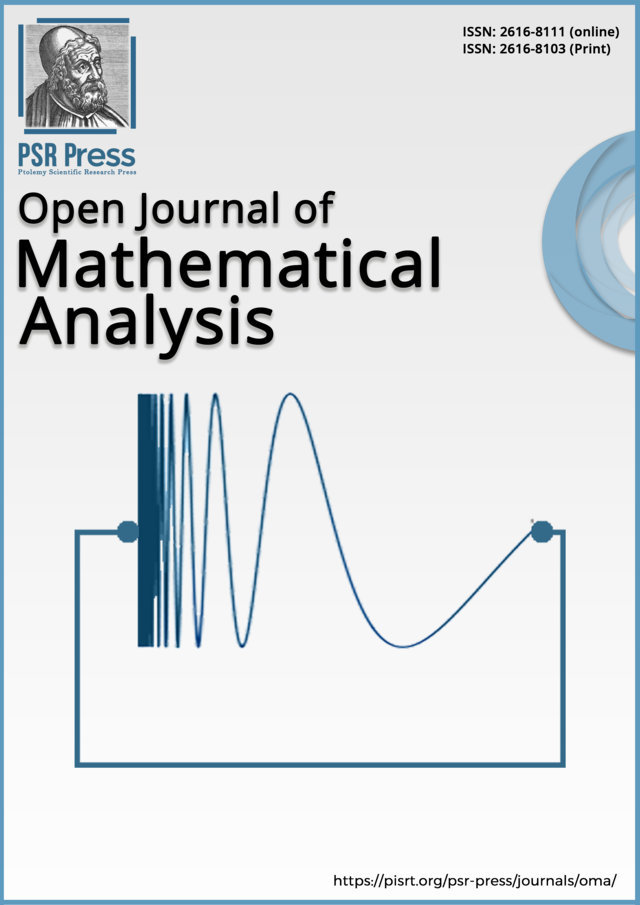Editor in Chief
Sever Silvestru Dragomir
Professor & Chair in Mathematical Inequalities
School of Engineering & Science
Victoria University, Melbourne Australia
Co-Editor in Chief
Imran Abbas Baloch
Punjab Higher Education Department, Lahore, Pakistan
Honorary Editor
Hari Mohan Srivastava
University of Victoria Victoria, British Columbia, Canada
Ravi P Agarwal
Texas A&M University-Kingsville, Kingsville, U.S.A
Janusz Brzdęk
Pedagogical University, Podchorążych 2, PL-30-084 Kraków, Poland
Imdat işcan
Faculty of Arts and Sciences, Giresun University, 28100, Giresun, Turkey
Managing Editor
Absar Ul Haq
University of Engineering and Technology, Lahore, Pakistan
Email: oma@pisrt.org
Advisory Board
Martin Bohner
Missouri University of Science and Technology Rolla, Missouri 65409-0020, USA
Vasile Lupulescu
University Constantin Brâncu¸si, Str. Geneva, Nr. 3, Târgu-Jiu, 210136, Romania
Donal O’Regan
National University of Ireland, Ireland
Associated Editor’s
Gaston N’Guerekata
Morgan State University, Baltimore, MD 21251, USA
Michael Th. Rassias
University of Zürich Winterthurerstrasse 190 CH-8057 Zürich Switzerland
Teodor Bulboaca
Babes-Bolyai University 400084 Cluj-Napoca, Romania
Marko Kostic
University of Novi Sad Trg D. Obradovi´ca 6, 21125 Novi Sad, Serbia
Armando Sánchez-Nungaray
Universidad Veracruzana, Lomas del Estadio S/N, Zona Universitaria, 91000 Xalapa, Ver., México
Wei-Shih Du
National Kaohsiung Normal University, Kaohsiung 82444, Taiwan
Gisele Mophou
Universite des Antilles, France
Sébastien Tremblay
Université du Québec à Trois-Rivières, Canada
Alberto Cabada
Universidade de Santiago de Compostela 15782, Santiago de Compostela, Galicia, Spain
Moshe Goldberg
Technion–Israel Institute of Technology Haifa 32000, Israel
Iosif Pinelis
Michigan Technological University Houghton, MI 49931, USA
Nak Eun Cho
Pukyong National University Busan 608-737, Korea
Antonella Nastasi
University of Palermo, Via Archirafi 34, 90123 Palermo, Italy
Giuseppe Marino
Universita Della Calabria Calabria, Rende, Italy
Simeon Reich
Israel Institute of Technology, Israel
M. Mursaleen
Aligarh Muslim University, Aligarh-202002, India
Arlúcio Viana
Federal University of Sergipe, São Cristóvão, Brazil
Hüseyin BOR
P.O.Box 121 06502 Bahçelievler Ankara, Turkey
Shane Wu
Longyan University, China
Qaisar Mehmood
Punjab Higher Education Department, Lahore, Pakistan
Mikail Et
Firat University, 23119 Elazig-TURKEY
Tibor K. Pogány
University of Rijeka, Studentska 2, 51000 Rijeka, Croatia
Ghaus ur Rahman
University of Swat, KP Pakistan
Senlin Guo
Zhongyuan University of Technology, China
Bilal Bilalov
National Academy of Sciences of Azerbaijan, Baku, Azerbaijan
Wulong Liu
Jiangxi University of Science and Technology, Ganzhou, Jiangxi 341000, China
Praveen Agarwal
Anand International College of Engineering, Jaipur-303012, India
Feng Qi
Tianjin Polytechnic University, Tianjin City, 300160, China
Vishnu Narayan Mishra
Indira Gandhi National Tribal University, India
Claudio Rodrigo Cuevas
Federal University of Pernambuco, Recife-PE, CEP 50540-740, Brazil
Rabha W. Ibrahim
University of Malaya, 50603 Kuala Lumpur, Malaysia
H. E. Darwish
Mansoura University, Mansoura, Egypt
Aref Jeribi
University of Sfax, Sfax, Tunisia
Choonkil Park
Hanyang University Seoul 04763, Korea
Irshaad Ahmed
Sukkur IBA University, Sukkur ,Pakistan
Lech Gorniewicz
Nicholas Copernicus University Chopina 12/18, 87-100 Torun, Poland
Farrukh Mukhamedov
The United Arab Emirates University P.O.Box, 15551, Al Ain, Abu Dhabi, UAE
W.S. Cheung
University of Hong Kong Pokfulam Road, Hong Kong
Rewayat Khan
Abbottabad University of Science and Technology, Pakistan
Fuad Kittaneh
The University of Jordan, Jordan

